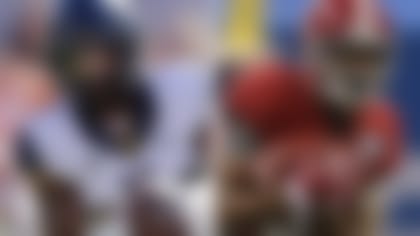Positional overviews: QBs | RBs | Interior DLs | Edge rushers | WRs/TEs | OLs | LBs
We finish our quick-hit position overviews for the 2015 NFL Draft with defensive backs.
The number of defensive backs selected in the first round has increased in each of the past three drafts -- from three in 2011 to five in '12 to seven in '13 to nine in '14. Of those 24 defensive backs, 15 have been corners. A corner has gone in the top 10 in each of the past five drafts, and one of the more interesting storylines this year will be whether a corner makes it into the top 10 in this draft. Potentially, as many as six corners -- but also as few as four -- could go in the first round overall.
Seven safeties have gone in the first round in the past two drafts, but only one this year -- Alabama's Landon Collins -- gets a first-round grade from NFL Media analyst Lance Zierlein. In all likelihood, the perceived lack of depth and talent at the position means a handful of safeties are going to be overdrafted this year.
Here's a quickie look at defensive backs in this draft, first corners, then safeties.
Cornerbacks
Teams with greatest need (in draft order): Tennessee (picks 2nd), Jacksonville (3rd), Oakland (4th), Minnesota (11th), San Francisco (15th), Philadelphia (20th), Pittsburgh (22nd), Detroit (23rd), Baltimore (26th), Dallas (27th), Green Bay (30th).
Mike Mayock's top 5 at the position: 1. Michigan State's Trae Waynes; 2. LSU's Jalen Collins; 3. Washington's Marcus Peters; 4. Wake Forest's Kevin Johnson; T-5. Utah's Eric Rowe; T-5. Connecticut's Byron Jones.
Biggest upside: Michigan State's Trae Waynes. Waynes (6-foot-0, 186 pounds) always was near the top of the cornerback rankings, then moved to No. 1 when he turned in a clocking of 4.31 seconds in the 40 at the NFL Scouting Combine. Waynes is known for his physicality and aggressiveness, and looks to have the needed skill set to be a press-man corner. He also was good against the run while with the Spartans. One issue is that he sometimes is too physical with his hands. But that's the way Michigan State corners are taught, and Waynes is savvy enough to scale back on that aspect of his game. Waynes -- a high school teammate of Melvin Gordon's in Kenosha, Wis. -- started for two seasons at Michigan State and left school after his junior year.
Most underrated: Florida State's P.J. Williams. Williams (6-0, 194) has good size, showed an ability to be a press-man corner at FSU and definitely plays with swagger. He also could be a slot corner. His 40 time at the combine (4.57) was poor, though he did improve that to 4.45 at FSU's pro day; plus, on tape, he does not look slow. He has some off-field issues, including a recent DUI arrest that could cause him to slide on some draft boards. Still, the team that gets him is going to get a guy whose style of play translates quite nicely to today's NFL. He will prove to be a first-round talent for the team that drafts him, and they will have gotten him on the second day of the draft.
Most overrated: Connecticut's Byron Jones. Jones (6-1, 199) is a physical marvel who was a four-year starter at UConn; after redshirting as a true freshman, he started at safety in 2011 and '12 before moving to cornerback for his final two seasons with the Huskies. He missed the final five games of his senior season with a shoulder injury. Jones is getting some mention as a potential first-round pick. From the athleticism standpoint, that makes perfect sense: He is one of the most athletic players in this draft. He's also an intelligent guy who majored in economics. But let's pump the brakes a bit. That athleticism doesn't show up consistently on the field and he was solid and nothing more at UConn, never making the all-conference team in the AAC or Big East. There are numerous corners in this draft who did more in college -- and in better leagues -- than Jones. Yes, the draft is all about potential, and Jones certainly has that. But he's not close to being a finished product.
Biggest sleeper: Marshall's Darryl Roberts. Roberts (6-0, 182) wasn't invited to the combine, but his size and athleticism (4.36 in the 40 and a 39-inch vertical jump at Marshall's pro day) -- not to mention his solid play at Marshall -- mean he likely will be a late-round pick. Roberts, who was a two-year starter for the Thundering Herd, led Conference USA with 17 pass breakups last season, and he was fifth on the team with 75 tackles, which is a testament to his willingness to provide run support. He could stand to add some bulk, but his speed and height are impressive.
Better pro than college player: Memphis' Bobby McCain. His size works against McCain (5-9 1/2, 195), but he is aggressive, reacts quickly and has good feet. He doesn't have elite speed (4.51 in the 40 at the combine), but his quick reaction helps make up for that. McCain was a four-year starter for Memphis who finished his career with 13 picks, including 11 in his final two seasons with the Tigers. He definitely has the skill set to be a slot corner. And while he might lack top-end speed, he is a good athlete; that athleticism coupled with his instincts give him a relatively high ceiling.
Top small-school prospect: Texas Southern's Tray Walker. Walker's measurables -- he is 6-2 and 187 pounds -- are a big selling point, and he had a good pro-day performance. Walker played football and was a track athlete (sprints and the long jump) in high school at powerful Miami Northwestern, where he was teammates with, among others, Teddy Bridgewater. Walker, who has long arms (almost 34 inches), is raw and needs technique work, but his size alleviates some concerns. FCS member Texas Southern hasn't had a player drafted since 2000. Among its football-playing alums are DE Michael Strahan, WR Ken Burrough and DT Ernie Holmes.
First-round grades (in order): Waynes, Collins, Johnson and Peters.
Safeties
Teams with greatest need (in draft order): Washington (picks 5th), Chicago (7th), New York Giants (9th), Philadelphia (20th), Pittsburgh (22nd), Indianapolis (29th).
Mike Mayock's top 5 at the position: 1. Arizona State's Damarious Randall; 2. Alabama's Landon Collins; 3. Washington's Shaq Thompson (most analysts view him as a linebacker); 4. Miami of Ohio's Quinten Rollins; T-5. Stanford's Alex Carter; T-5. Samford's Jaquiski Tartt.
Biggest upside: Arizona State's Damarious Randall. Randall (5-11, 196) supposedly is rocketing up draft boards; not bad for a guy who went to junior college to play baseball, not football. Randall is from Pensacola, Fla., and played baseball at Butler County (Kan.) CC in 2011. He moved to Mesa (Ariz.) CC in 2012 and played both cornerback and safety. He started for the past two seasons as a safety at Arizona State, and his coverage skills are a big selling point. He played in a highly aggressive defensive scheme at Arizona State, which asks all of its defensive backs to spend a lot of their time in man coverage. He has good ball skills (nine picks in junior college, six in two seasons at ASU) and good speed (4.46 in the 40). The thought is that once he settles in to a "normal" defensive scheme, his coverage skills will be put to good use as a free safety.
Most underrated: Northwestern State's Imoan Claiborne. Claiborne (5-11, 187) went to the Reese's Senior Bowl but wasn't invited to the combine. He started for two years at cornerback for FCS member Northwestern State (La.). He likely fits best at safety at the next level because he lacks top-end speed. But Claiborne has good footwork and can be a disruptive player in press-man coverage. If he doesn't move to safety, he could be used as a slot corner.
Most overrated: Louisville's Gerod Holliman. Holliman (6-0, 218) had a season for the ages as a junior in 2014, finishing with 14 interceptions, which tied an NCAA single-season record. He won the Jim Thorpe Award as the nation's top defensive back. But there are some issues. Yes, he is a ballhawk. But he started for just one season, is a bad (and not-very-willing) tackler and tends to freelance too much in an effort to make a big play.
Biggest sleeper: Western Michigan's Donald Celiscar. Celiscar (5-11, 194) was a cornerback at Western Michigan, but looks to fit best as a safety in the NFL. He was a three-year starter at cornerback for Western, with 10 interceptions and 45 pass breakups in his career. He lacks top-end speed, but he is physical, has good ball skills and had success as a press corner in college. Those coverage skills will serve him well at safety. He should be a third-day pick.
Better pro than college player: Samford's Jaquiski Tartt. Tartt (6-1, 221), who has good size, has a high ceiling. He played just one season of high school football, then started for his final three seasons at Samford, a FCS school in Birmingham, Ala. He was extremely productive for the Bulldogs; he had a combined 160 tackles in his final two seasons. He finished his career with six interceptions, 20 pass break-ups and 6.5 tackles for loss. But he did all that without truly knowing the nuances of the position. Once he gets fully acclimated, he could be a special safety.
Top small-school prospect: Tartt. Here's Tartt again. He has some rough edges to smooth out -- for instance, while he is solid in run support, he has some work to do in coverage -- but he could become a standout. He played at the same high school -- Mobile (Ala.) Davidson -- as San Francisco 49ers safety Jimmie Ward, who was a first-round pick in the 2014 draft out of Northern Illinois.
First-round grades: Collins.
Mike Huguenin can be reached at mike.huguenin@nfl.com. You also can follow him on Twitter @MikeHuguenin.










